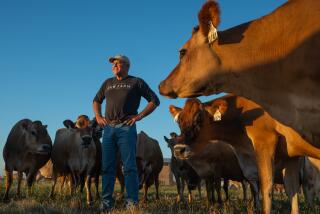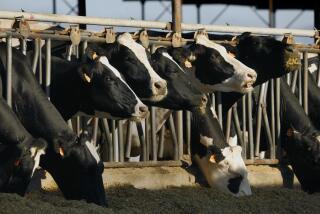Cattle Inspectors Always Make Sure to Check Label : Livestock: Although rustling is rare, brand inspectors in North Dakota still watch out for thievery.
BISMARCK, N.D. â In the Old West, a man caught stealing another manâs cow was likely to find his neck in a noose by sundown.
Today the penalties for cattle rustling are far less severe, but North Dakotaâs brand inspectors still keep watch for livestock thievery.
âWe have very few repeat offenders,â Jack Chase, North Dakotaâs chief brand inspector, said with a smile. âIn the eight years Iâve been chief, I think weâve had only two repeaters. Once they get caught, they rarely do it again.â
The maximum penalty for getting caught with someone elseâs cattle is a $500 fine and a year in jail. But seldom is such a penalty imposed.
First-time offenders usually get off with a warning, said Dennis Mosbrucker, one of about 35 brand inspectors working across the state.
Mosbrucker, who is based at an auction house in Mandan, is charged with making sure the cattle that farmers and ranchers want to sell belong to them.
âWe catch someone every once in a while,â he said. âBut the laws arenât very tough. Itâs not like the old days when they used to hang guys.â
Mosbrucker spends his days climbing through pens full of cattle, checking the brand on each animal against a wad of livestock title papers.
âI got kicked really good a few months ago. Broke my knee,â he said.
Ranchers--somewhat like car owners--must have written proof of ownership and written proof that the brand on the animal is theirs before they can sell.
If not, Mosbrucker can prevent the cow from being sold or--more likely--allow the sale but hold the money until the rightful owner is determined.
If he suspects that a cow is stolen, Mosbrucker calls Chase or one of two field supervisors, who investigate.
Chase, a former steer wrestler on the rodeo circuit, works for the private North Dakota Stockmenâs Assn. but is empowered by the state to investigate and make arrests.
Cattle are big business in North Dakota--the second-largest income producer among agriculture operations in the state after wheat, said Lyle Dawson, livestock director of the state Department of Agriculture.
Inspectors check about 1.5 million cattle annually and return about $200,000 in stolen or âstrayâ animals to their rightful owners, Chase said.
âSometimes a guy will have his neighborâs critter and heâll say, âGee, I didnât know I had that,â and weâd have a tough time proving he was trying to steal it,â Mosbrucker said.
All livestock leaving North Dakota must be inspected, but Chase admitted it is impossible to stop every cattle truck. But modern technology has made the job of determining who owns the animals easier.
The Agriculture Department has a new computer program that keeps track of the more than 22,000 brands. An animalâs owner can be identified in seconds by typing in an inspectorâs phoned-in description of a brand and its location.
Despite the technology, Chase and Mosbrucker said their jobs havenât changed much--and probably never will.
âTheyâve talked about putting little computer chips under the cowsâ skin and having us carry some sort of little scanner gun,â Mosbrucker said, âbut weâd still be standing out here in the cow poop.â
More to Read
Sign up for Essential California
The most important California stories and recommendations in your inbox every morning.
You may occasionally receive promotional content from the Los Angeles Times.










